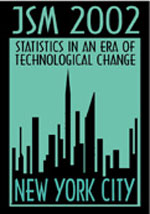|
Title
|
|
* ! Visualization Technology and Geographic Information Science
|
|
Date / Time / Room
|
Sponsor
|
Type
|
08/15/2002
10:30 AM -
12:20 PM
Room: H-Beekman Parlor
|
Section on Physical & Engineering Sciences*, Section on Statistical Graphics*, Section on Statistics & the Environment*, University Consortium for Geographic Information Science
|
Invited
|
|
Organizer:
|
Arthur Getis, San Diego State University
|
|
Chair:
|
Arthur Getis, San Diego State University
|
|
Discussant:
|
11:45 AM - Duane F. Marble, Ohio State University
|
|
Floor Discussion
|
12:05 PM
|
Description
Geographic Information Science takes advantage of powerful new technologies that greatly improve our ability to collect, store, manage, analyze, and utilize information regarding the features of the Earth's surface. These technologies include geographic information systems (GIS), global positioning systems (GPS), and satellite-based remote sensing. The University Consortium for Geographic Information Science (UCGIS), an organization with over 60 university members, and a number of governmental agencies and private firms as affiliate members, represents these scientific interests in the United States. Members of UCGIS have developed this session to help fulfill one of the organization's goals: to foster multidisciplinary research and education. Many of the membership of UCGIS can provide useful assistance to those in the field of statistics. Members of UCGIS have identified a number of research challenges, including: spatial data acquisition and integration, distributed computing, spatial analysis in a GIS environment, and the study of uncertainty in spatial data. Recently, UCGIS expanded its list of interest areas to include geographic visualization.
In this session, especially prepared for professional statisticians, several researchers will present aspects of their work that bear on technology and cognition in visualization of geo-referenced data, with special emphasis on spatial uncertainty. Geographic visualization provides an approach to data analysis that draws on a diverse research literature, including statistics (exploratory data analysis, data presentation), computer science (graphics, geometry, software engineering), and cognitive science (human perception and cognition). The aim is to create graphic aids to facilitate knowledge extraction from complex data sets. A research agenda will be outlined that includes the integration of visual and analytical methods.
The presenters will discuss the perceptual and cognitive principles of visualization and their relevance to spatial data and spatial data uncertainty. Interest and capabilities in this area have been growing rapidly in recent years, mainly as a response to advances in computer technology and software developments. This session should appeal to a wide variety of statisticians, especially those who deal with large data sets, data exploration, and data mining. The presentations will demonstrate useful graphics and animations.
|
|

